The Vision Zero bill (HB 5917) is waiting for Gov. Lamont’s signature, and is a promising foot-in-the-door kind of legislation, even though it wound up being diluted in order to win enough votes. There is far more in the package than just automated enforcement, and despite news headlines implying that these cameras are “rolling out,” anyone who has sat with the bill knows that there is a lot of process involved before a single camera can be installed in each town/city. That’s part of what was so frustrating for safety advocates this session: hearing that cameras were going to be used against people of color, knowing that the bill was drafted such that cameras could not be placed any which way. The recommendations made by the Vision Zero Council were shaped by previously voiced concerns and those that came up during the year of meetings the culminated in the Vision Zero bill. The last few weeks of this session were spent correcting misinformation (that had been distributed without an editor’s note correcting false info) because people were either unwilling to read the bill, or were intentionally claiming it would do something it would not.
How do we get people to pause, read the material in question, think about it, and then participate in the conversation? I don’t know. Already, I have to ask people to read in full what I post here before unleashing their commentary. At least from years of teaching, I know when someone has not done the reading, and I’m not afraid to say so.
This does matter, because while the news suctioned to the segment of HB 5917 dealing with automated enforcement, there is so much more in the bill that barely got a mention. Had more vocal opponents bothered to do the reading, they may have realized that there was a lot that they actually liked in it, and considered how these different tools were meant to work together.
From the “I Shit You Not” Files, I’ve seen people oppose cameras while claiming to care about equity issues, simultaneously refusing to acknowledge the equity issue far more pressing than whether or not someone who has broken a law in a way that endangers others’ lives receives a ticket in the mail: Black and Indigenous people suffer road deaths at a disproportionate rate. THIS is THE issue. From maintaining the pedestrian murder map, I can confirm that Connecticut is no exception to this terrible nationwide trend. Yet, groups purporting to be for these populations have yet to show leadership in tackling this problem.
Also, from the “I Shit You Not” Files, during the last legislative session I saw people oppose HB 5917 because cameras, saying that what we really need is for pedestrians and cyclists to be educated about the ‘rules of the road’. First of all, when that phrase is used, you know the person saying it unlikely understands what the rules are. (Sorry bro, street safety advocates literally carry brochures around with these rules to hand out to drivers who buzz us while rushing to the next stop light). But secondly, there are several education components — for all road users — in HB 5917, which people would have known had they taken the time to read it. There’s the piece for educating youth in school, there’s the piece for educating drivers when renewing their license or moving to Connecticut, there’s the piece fo re-educating drivers after they have violated certain traffic laws. There’s also a public awareness campaign on drug-impaired driving. Predictably, some were opposed to needing to complete that short educational requirement for license renewal. Who are these people who got their license in like 1980 and feel entitled to not do any kind of continuing education?
It was never just the red light camera bill. It had twelve sections, with two being excised — those that would have banned open alcohol containers in the passenger area of vehicles (i.e. not stored in trunk) and mandated motorcycle helmets be worn by riders of all ages. I was happy to see the helmet part dropped. It may be a good idea for everyone to wear them while riding — and whenever I’ve been on a motorcycle, I have worn a helmet — but ultimately, failing to do so would only directly impact that person, physically; it would not cause injuries to anyone else. It needs to be said that there are other significant and fatal injuries a motorcycle rider can receive, despite wearing a helmet, and that the focus should be on how to prevent the crash in the first place. There needs to be legislation on the national level for requiring manufacturers to install speed limiters on all vehicles. We know that speed kills, and it will never be not confusing to me that rental e-scooters in Hartford have been limited to going no faster than 15 MPH, but no such device to reasonably limit speeds have been installed on motorcycles or cars.
My favorite section of the bill is actually one that could be a giant dead end, or could be pivotal: the required study. It says that “Under the bill, the DOT commissioner must study (1) allowing bicyclists to treat a stop sign as a yield sign and red light as a stop sign (known as the “Idaho Stop”) and (2) prohibiting right turns at red lights.” Cyclists, do not stop reading after the first part! That’s nice and important, but the diamond apparently hidden in this bill is that Connecticut is going to need to explore the feasibility of outlawing the practice of motorists turning right on red. Go stand at the park corner of Broad and Capitol in Hartford and wait for the pedestrian light. Count how many people turn right on red from Capitol Avenue westbound to Broad Street northbound, and then tell me how many came to a full, or hell, even a partial stop before doing so. Those two items the commissioner “must study” have been proven safety improvements elsewhere, and since Connecticut ain’t that special, we should expect positive results. And then, if our legislators have any sense, we can adopt that safety measure and because HB 5917 passed, municipalities that have any sense will have already installed automated enforcement cameras at intersections were there has been a history of serious and fatal collisions resulting from drivers speeding and/or running red lights. Those who spend any considerable time walking or jogging can attest to how many drivers only look left before making right turns, ignoring the existence of anyone who may have already begun using the crosswalk.
If you have not read HB 5917, go see what else is in it.
It’s not a magic wand, but we should see a reduction in preventable roadway deaths as a result. Meanwhile, as we await these changes, ask the decisionmakers in your town if they applied for the SS4A grant that would fund infrastructure improvements, and if not, why not. Keep asking until they provide a satisfactory answer or show you that they are now working on an application.
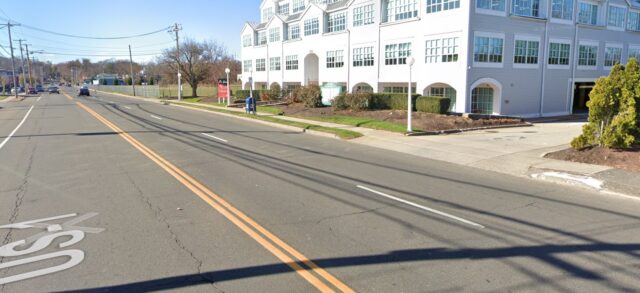
On the morning of May 17, 2023, a 19-year old driver struck and killed Stephen Brynn as he was doing surveying work in a business driveway in Fairfield. This happened at about 9:15 AM on a clear, dry day.
Currently, no other details about the crash have been made public, but this business is located on Route 1 where there are four lanes and a 30 MPH speed limit (just one block from where it changes to 35 MPH). Anyone who has spent a minute standing on the sidewalk of the Post Road can tell you that this speed limit is often exceeded, and that motorists frequently make quick turns into driveways, perhaps out of fear of being rearended, or because they are making a left turn after finding a rare break in an area with lots of traffic and lots of other driveways that drivers would be pulling out of without much warning.
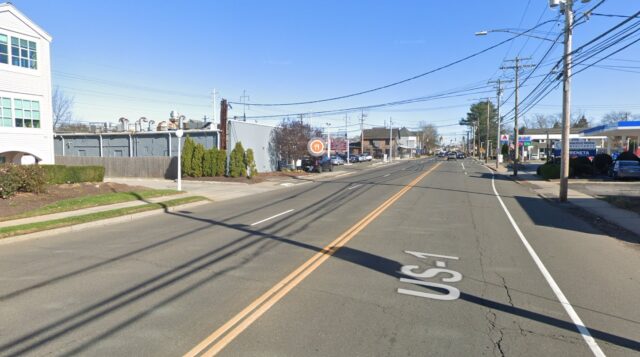
Reports did not indicate if the motorist caused this collision while entering or exiting a driveway, but it was consistently described as happening in the driveway, not the parking garage. This is not yet in the database. No doubt, those investigating this have had loads of video to review.
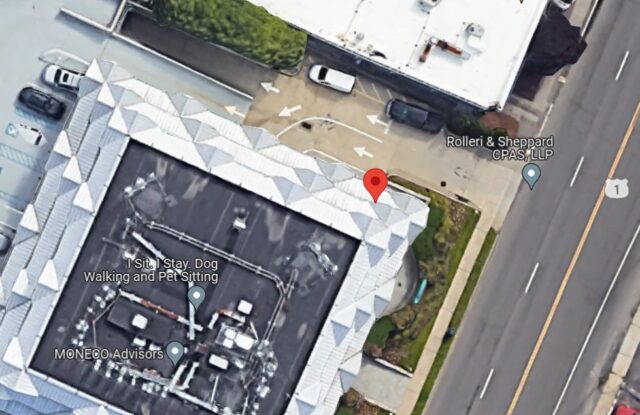
On May 4, 2023, thirteen days before this fatal collision, Fairfield residents began circulating an online petition calling upon First Selectwoman Brenda Kupchick, and other electeds, to reduce speed limits and install traffic calming infrastructure in town. So far, the petition has almost 400 signatures.
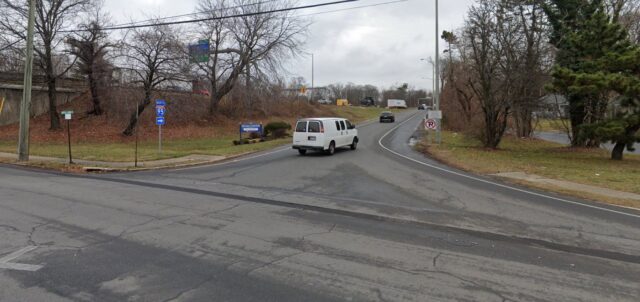
If you live in Fairfield or regularly use its roads, consider signing the petition, as local decisionmakers are not taking seriously pedestrian safety. Just half a mile from where Stephen Brynn was killed last month, in 2020 69-year old Christine McMahon was struck and killed by someone driving a Ford F350 Super Duty while she crossed an I-95 entrance ramp on Mill Plain Road. She was walking with another person when killed, and he was injured as well. The crash report describes the area as having been dark, not lighted. Although sidewalk leads to and from this crossing, there was no marked crosswalk three years ago and there is no marked crosswalk there now.
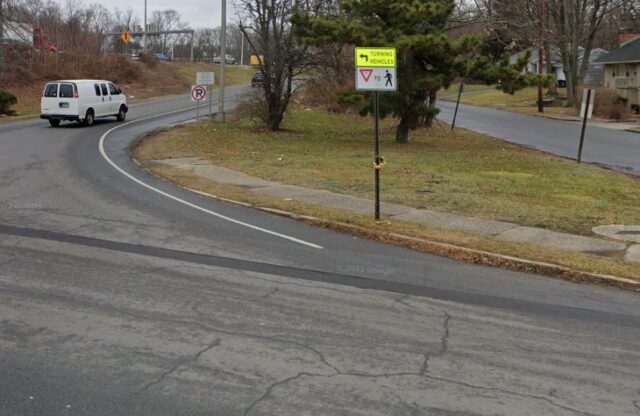
All that the town has done since is add an absolute joke of a sign that is barely visible to anyone speeding down this road.
It bears mentioning that when I walked here recently with a friend — obeying every single road rule — we were narrowly missed by someone making a tire-squealing left turn from Mill Plain Road into the nearby train station driveway. In a town with such vast wealth, it is hard to figure out why there isn’t better infrastructure.
The photo below was recently taken on Route 1 (Post Road) at one of the few intersections with a signalized pedestrian crossing. There is no curb ramp that would make this accessible to those using mobility devices, and for whatever reason, it was decided that this exact spot was totally fine for a UPS box.
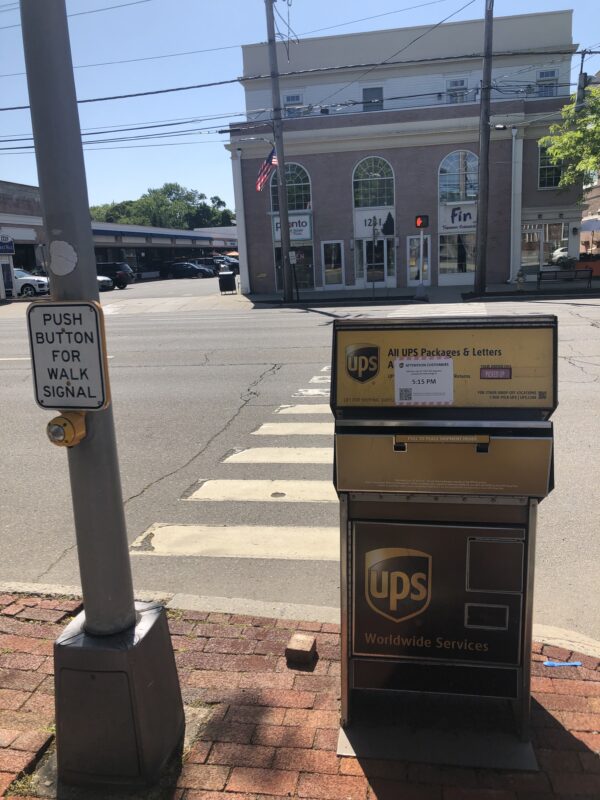
Instead of helping people on foot access any of the many restaurants or shops along Route 1, it seems some are stuck with “solutions” like awareness signs that have done little to nothing over the last century. Luckily, Fairfield residents are speaking up about this, and their electeds would do well to listen.
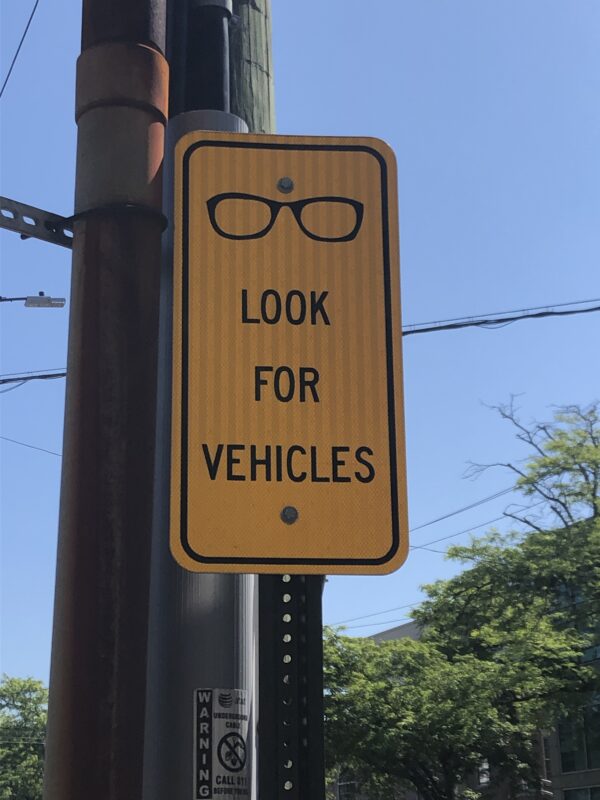
Besides Stephen Brynn’s preventable death, there were at least 96 crashes in Connecticut last month in which a pedestrian/cyclist was injured. In 14 of those crashes, the injuries were described as “serious.” Even the most avid reader of the news would be unaware of the 14 serious collisions. To get this info, you need to look in databases.
Those injured included a three-year old child, an 88-year old person walking, a people of all ages in between.
In one crash, an adult was injured but the 1-year old being carried by her, thankfully, was not.
Three crashes happened even though those struck were wearing reflective clothing; these were in Shelton, Tolland, and Stamford. The collision in Shelton was in a work zone where there was a police officer present to direct traffic. The one in Stamford was in a parking lot.
In ten crashes with injuries, the person was wearing a helmet. Those happened in Hamden, Norwalk, Bristol, Trumbull, Greenwich, Enfield, New Haven, New Britain, Branford, and Danbury.
In West Hartford, a cyclist was riding on the sidewalk on Mountain Road and was clipped by a driver making a left turn onto Buena Vista. Looking through the data and diagrams, there were quite a few pedestrians hit across the state who were using the sidewalk, indicating the drivers are not looking before turning in or out of driveways, or in some cases, approached the roadway too fast instead of pausing before driving across the sidewalk area. Drivers were sideswiping cyclists – a sign that there is a need for education about the three-foot passing rule. There were cases of drivers not stopping — or proceeding through a stop sign — even though the cyclist riding through the intersection had no stop sign, and had the right of way just as a car would in the same spot.
Year-to-date, there have been 483 pedestrian/cyclist crashes resulting in injury listed in the CT Crash Data Repository, and with some towns slow to process their reports, we can assume that the actual number is much higher.
Safe Streets Connecticut: May 2023
The Vision Zero bill (HB 5917) is waiting for Gov. Lamont’s signature, and is a promising foot-in-the-door kind of legislation, even though it wound up being diluted in order to win enough votes. There is far more in the package than just automated enforcement, and despite news headlines implying that these cameras are “rolling out,” anyone who has sat with the bill knows that there is a lot of process involved before a single camera can be installed in each town/city. That’s part of what was so frustrating for safety advocates this session: hearing that cameras were going to be used against people of color, knowing that the bill was drafted such that cameras could not be placed any which way. The recommendations made by the Vision Zero Council were shaped by previously voiced concerns and those that came up during the year of meetings the culminated in the Vision Zero bill. The last few weeks of this session were spent correcting misinformation (that had been distributed without an editor’s note correcting false info) because people were either unwilling to read the bill, or were intentionally claiming it would do something it would not.
How do we get people to pause, read the material in question, think about it, and then participate in the conversation? I don’t know. Already, I have to ask people to read in full what I post here before unleashing their commentary. At least from years of teaching, I know when someone has not done the reading, and I’m not afraid to say so.
This does matter, because while the news suctioned to the segment of HB 5917 dealing with automated enforcement, there is so much more in the bill that barely got a mention. Had more vocal opponents bothered to do the reading, they may have realized that there was a lot that they actually liked in it, and considered how these different tools were meant to work together.
From the “I Shit You Not” Files, I’ve seen people oppose cameras while claiming to care about equity issues, simultaneously refusing to acknowledge the equity issue far more pressing than whether or not someone who has broken a law in a way that endangers others’ lives receives a ticket in the mail: Black and Indigenous people suffer road deaths at a disproportionate rate. THIS is THE issue. From maintaining the pedestrian murder map, I can confirm that Connecticut is no exception to this terrible nationwide trend. Yet, groups purporting to be for these populations have yet to show leadership in tackling this problem.
Also, from the “I Shit You Not” Files, during the last legislative session I saw people oppose HB 5917 because cameras, saying that what we really need is for pedestrians and cyclists to be educated about the ‘rules of the road’. First of all, when that phrase is used, you know the person saying it unlikely understands what the rules are. (Sorry bro, street safety advocates literally carry brochures around with these rules to hand out to drivers who buzz us while rushing to the next stop light). But secondly, there are several education components — for all road users — in HB 5917, which people would have known had they taken the time to read it. There’s the piece for educating youth in school, there’s the piece for educating drivers when renewing their license or moving to Connecticut, there’s the piece fo re-educating drivers after they have violated certain traffic laws. There’s also a public awareness campaign on drug-impaired driving. Predictably, some were opposed to needing to complete that short educational requirement for license renewal. Who are these people who got their license in like 1980 and feel entitled to not do any kind of continuing education?
It was never just the red light camera bill. It had twelve sections, with two being excised — those that would have banned open alcohol containers in the passenger area of vehicles (i.e. not stored in trunk) and mandated motorcycle helmets be worn by riders of all ages. I was happy to see the helmet part dropped. It may be a good idea for everyone to wear them while riding — and whenever I’ve been on a motorcycle, I have worn a helmet — but ultimately, failing to do so would only directly impact that person, physically; it would not cause injuries to anyone else. It needs to be said that there are other significant and fatal injuries a motorcycle rider can receive, despite wearing a helmet, and that the focus should be on how to prevent the crash in the first place. There needs to be legislation on the national level for requiring manufacturers to install speed limiters on all vehicles. We know that speed kills, and it will never be not confusing to me that rental e-scooters in Hartford have been limited to going no faster than 15 MPH, but no such device to reasonably limit speeds have been installed on motorcycles or cars.
My favorite section of the bill is actually one that could be a giant dead end, or could be pivotal: the required study. It says that “Under the bill, the DOT commissioner must study (1) allowing bicyclists to treat a stop sign as a yield sign and red light as a stop sign (known as the “Idaho Stop”) and (2) prohibiting right turns at red lights.” Cyclists, do not stop reading after the first part! That’s nice and important, but the diamond apparently hidden in this bill is that Connecticut is going to need to explore the feasibility of outlawing the practice of motorists turning right on red. Go stand at the park corner of Broad and Capitol in Hartford and wait for the pedestrian light. Count how many people turn right on red from Capitol Avenue westbound to Broad Street northbound, and then tell me how many came to a full, or hell, even a partial stop before doing so. Those two items the commissioner “must study” have been proven safety improvements elsewhere, and since Connecticut ain’t that special, we should expect positive results. And then, if our legislators have any sense, we can adopt that safety measure and because HB 5917 passed, municipalities that have any sense will have already installed automated enforcement cameras at intersections were there has been a history of serious and fatal collisions resulting from drivers speeding and/or running red lights. Those who spend any considerable time walking or jogging can attest to how many drivers only look left before making right turns, ignoring the existence of anyone who may have already begun using the crosswalk.
If you have not read HB 5917, go see what else is in it.
It’s not a magic wand, but we should see a reduction in preventable roadway deaths as a result. Meanwhile, as we await these changes, ask the decisionmakers in your town if they applied for the SS4A grant that would fund infrastructure improvements, and if not, why not. Keep asking until they provide a satisfactory answer or show you that they are now working on an application.
On the morning of May 17, 2023, a 19-year old driver struck and killed Stephen Brynn as he was doing surveying work in a business driveway in Fairfield. This happened at about 9:15 AM on a clear, dry day.
Currently, no other details about the crash have been made public, but this business is located on Route 1 where there are four lanes and a 30 MPH speed limit (just one block from where it changes to 35 MPH). Anyone who has spent a minute standing on the sidewalk of the Post Road can tell you that this speed limit is often exceeded, and that motorists frequently make quick turns into driveways, perhaps out of fear of being rearended, or because they are making a left turn after finding a rare break in an area with lots of traffic and lots of other driveways that drivers would be pulling out of without much warning.
Reports did not indicate if the motorist caused this collision while entering or exiting a driveway, but it was consistently described as happening in the driveway, not the parking garage. This is not yet in the database. No doubt, those investigating this have had loads of video to review.
On May 4, 2023, thirteen days before this fatal collision, Fairfield residents began circulating an online petition calling upon First Selectwoman Brenda Kupchick, and other electeds, to reduce speed limits and install traffic calming infrastructure in town. So far, the petition has almost 400 signatures.
If you live in Fairfield or regularly use its roads, consider signing the petition, as local decisionmakers are not taking seriously pedestrian safety. Just half a mile from where Stephen Brynn was killed last month, in 2020 69-year old Christine McMahon was struck and killed by someone driving a Ford F350 Super Duty while she crossed an I-95 entrance ramp on Mill Plain Road. She was walking with another person when killed, and he was injured as well. The crash report describes the area as having been dark, not lighted. Although sidewalk leads to and from this crossing, there was no marked crosswalk three years ago and there is no marked crosswalk there now.
All that the town has done since is add an absolute joke of a sign that is barely visible to anyone speeding down this road.
It bears mentioning that when I walked here recently with a friend — obeying every single road rule — we were narrowly missed by someone making a tire-squealing left turn from Mill Plain Road into the nearby train station driveway. In a town with such vast wealth, it is hard to figure out why there isn’t better infrastructure.
The photo below was recently taken on Route 1 (Post Road) at one of the few intersections with a signalized pedestrian crossing. There is no curb ramp that would make this accessible to those using mobility devices, and for whatever reason, it was decided that this exact spot was totally fine for a UPS box.
Instead of helping people on foot access any of the many restaurants or shops along Route 1, it seems some are stuck with “solutions” like awareness signs that have done little to nothing over the last century. Luckily, Fairfield residents are speaking up about this, and their electeds would do well to listen.
Besides Stephen Brynn’s preventable death, there were at least 96 crashes in Connecticut last month in which a pedestrian/cyclist was injured. In 14 of those crashes, the injuries were described as “serious.” Even the most avid reader of the news would be unaware of the 14 serious collisions. To get this info, you need to look in databases.
Those injured included a three-year old child, an 88-year old person walking, a people of all ages in between.
In one crash, an adult was injured but the 1-year old being carried by her, thankfully, was not.
Three crashes happened even though those struck were wearing reflective clothing; these were in Shelton, Tolland, and Stamford. The collision in Shelton was in a work zone where there was a police officer present to direct traffic. The one in Stamford was in a parking lot.
In ten crashes with injuries, the person was wearing a helmet. Those happened in Hamden, Norwalk, Bristol, Trumbull, Greenwich, Enfield, New Haven, New Britain, Branford, and Danbury.
In West Hartford, a cyclist was riding on the sidewalk on Mountain Road and was clipped by a driver making a left turn onto Buena Vista. Looking through the data and diagrams, there were quite a few pedestrians hit across the state who were using the sidewalk, indicating the drivers are not looking before turning in or out of driveways, or in some cases, approached the roadway too fast instead of pausing before driving across the sidewalk area. Drivers were sideswiping cyclists – a sign that there is a need for education about the three-foot passing rule. There were cases of drivers not stopping — or proceeding through a stop sign — even though the cyclist riding through the intersection had no stop sign, and had the right of way just as a car would in the same spot.
Year-to-date, there have been 483 pedestrian/cyclist crashes resulting in injury listed in the CT Crash Data Repository, and with some towns slow to process their reports, we can assume that the actual number is much higher.
Related Posts
Improving Parks, One Carriage Ride at a Time
Bring Our War $$$ Home Rally and March
Look: Bowles Park / Willow Creek (2 of 2)